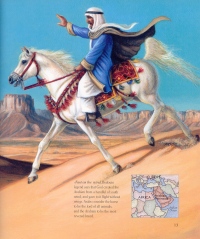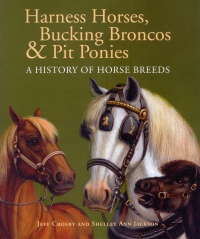| ________________
CM . . . . Volume XVIII Number 16 . . . . December 16, 2011
excerpt:
There are 58 million horses in the world today, and no other animal has had a greater impact on human civilization. Whether they pulled chariots or farm carts, or travelled with a single rider, horses were the swiftest, most dependable form of transportation for 4,000 years. Over time, horses were bred to have specialized characteristics to suit their purpose and their environment. For example, horses who lived in mountain regions needed to have stronger hearts and lungs to breathe the air in high altitudes and sickle-shaped legs for sure-footedness, while desert-dwelling horses needed to have dry skin to allow the heat to escape, and northern dwellers required double coats to protect them from the cold. 
Following a brief history of the domestication of horses and an explanation of artificial selection (which creates different breeds of horses with various characteristics suited to their purpose), the book is divided into five main sections based on specific groups of horses- those bred for speed, military use (such as hauling heavy artillery, carrying armoured knights and carting the wounded out of battle), pulling heavy loads, and entertainment (some examples are dressage and rodeo). The fifth section features feral horses which are descended from domestic horses but live in the wild. With over 200 horse breeds, it would have been difficult to include them all, so the authors provide information on 43 of them, with about nine or 10 examples, some of them better known than others, in most of the categories. Where necessary, the pronunciation of the horse’s breed is provided. One fairly lengthy paragraph is devoted to each type of horse. It is presented on either a single page or a double-page spread. Information includes the history of the breed and the area of the world in which the type of horse was first bred, where it can be found today, the horse’s physical characteristics, its “personality”, and its gait. A small inset map shows its country of origin while text boxes provide additional facts. Some of the lesser known breeds that readers will learn about include the Peruvian Paso, whose “mountain sense” helps it to stay calm when walking through narrow mountain passageways, the Marwari from India, whose unique physical feature is its ears which curve towards one another, often touching, and the Azteca, the preferred mount of Mexican charros (cowboys). A table of contents is provided. Illustrations consist of beautifully rendered paintings which show the horses in their original habitats and performing the duties for which they were bred. Some examples include the Appaloosa carrying its Nez Percé rider on a buffalo hunt, a Gypsy Vanner pulling a caravan, and a team of Clydesdales hauling a wagonload of coal. Readers will get a sense of history as they peruse the illustrations. The authors’ admiration and respect for horses are clearly evident throughout this book, and, though the book is the perfect read for horse lovers, one need not be a horse enthusiast to thoroughly enjoy it. Highly Recommended. Gail Hamilton is a former teacher-librarian in Winnipeg, MB.
To comment
on this title or this review, send mail to cm@umanitoba.ca.
Copyright © the Manitoba Library Association. Reproduction for personal
use is permitted only if this copyright notice is maintained. Any
other reproduction is prohibited without permission.
NEXT REVIEW |
TABLE OF CONTENTS FOR THIS ISSUE
- December 16, 2011.
AUTHORS |
TITLES |
MEDIA REVIEWS |
PROFILES |
BACK ISSUES |
SEARCH |
CMARCHIVE |
HOME |
